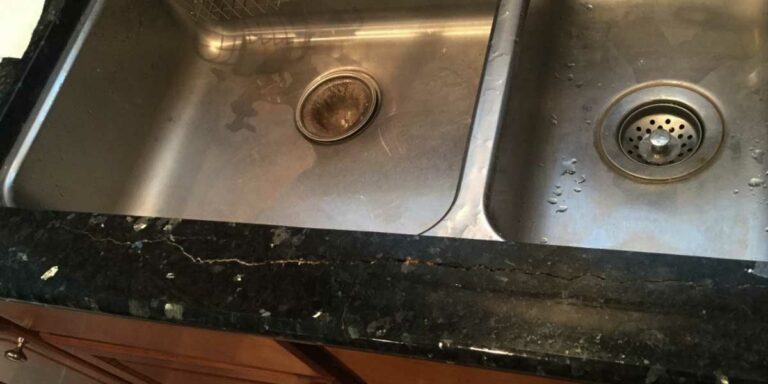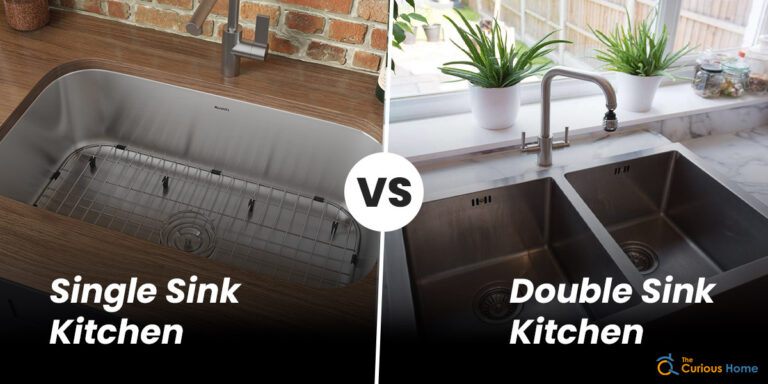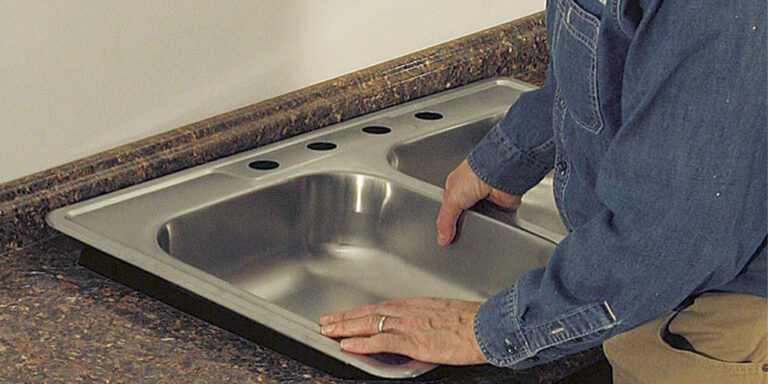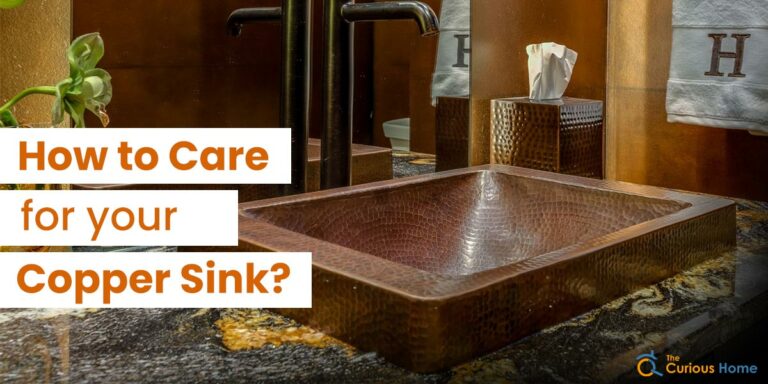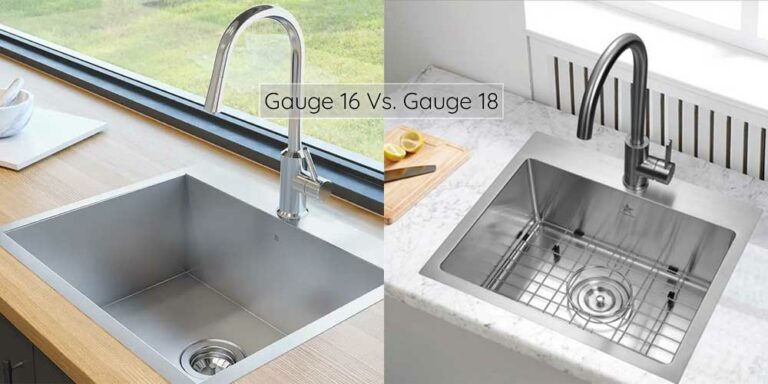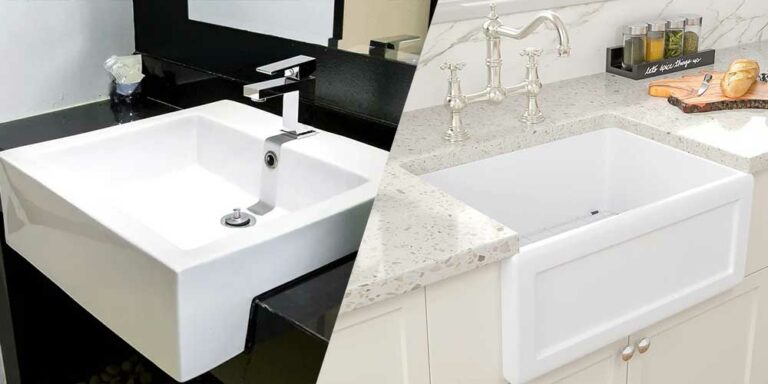Fireclay Vs Cast Iron Sinks |What Should You Go For?
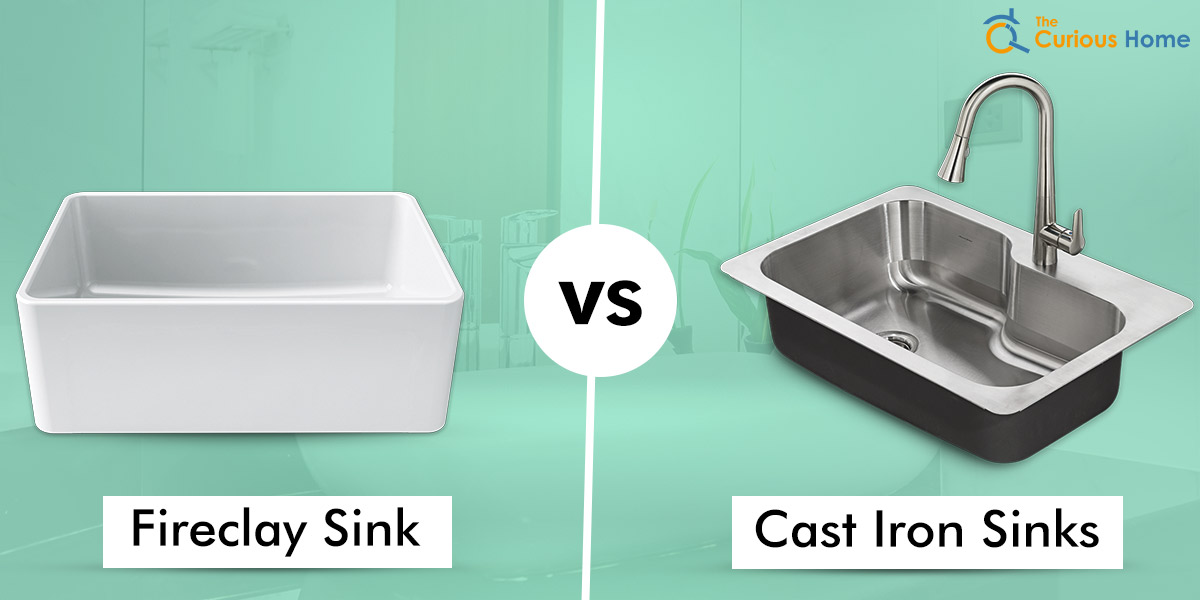
In many houses, the kitchen is one of the primary gathering places for family members. And, in the kitchen, the sink is, at the very least, the most used place. There have always been debate on various materials used in kitchen sinks such as is stainless steel better than cast iron or should I go for Granite composite or Stainless steel material.
For millennia Fireclay versus cast iron sinks have always been around and recently seen a comeback in popularity. Each has unique traits, as well as perks and pitfalls to consider. If you’re planning to choose from the best farmhouse sinks or apron sinks, you might be wondering what your alternatives are. Today we’ll look at cast iron and fireclay sinks today to help you understand the differences and make a well-informed selection.
What Is A Fireclay Sink?
Fireclay, as the name indicates, is a clay-based substance that is burnt at extremely high temperatures in a kiln. A fireclay is a form of ceramic; however, the fire process welds the glaze to the clay, greatly improving the material’s strength and integrity. Fireclay sinks are an excellent choice for a beautiful, classic farmhouse look. The clay is a regular mud with a greater aluminum content.
It is significantly whiter than other varieties of clay. Fireclay is formed at extremely high temperatures, then hardens when it cools and dries. To help reinforce the sink, porcelain enamel can be applied. Because the clay may be poured and molded in any configuration, including the addition of artistic decorations, fireclay sinks are incredibly adaptable. For many homes, fireclay is a more inexpensive luxury than other materials.
How Much Do Fireclay Sinks Cost?
When selecting a sink, there are several small drawbacks to consider, most notably the price. It can be pricey because of its high quality; good-grade sinks range in price from several hundred to several thousand dollars. A person does not need to spend a lot of money to have a good sink; a cheaper price does not always imply a worse quality.
The Upsides to Using A Fireclay Sink
1. Durability and strength
Because it is kiln-fired, fireclay is extremely resilient and can withstand harsh impacts or whatever you throw at it. Do you have any heavy-duty, enamel-coated pots and pans that need to soak before cleaning? Put them in. You don’t have to worry about them scuffing the sink base and leaving marks with a fireclay sink.
2. Minimal Upkeep
Because of the strength and longevity of the fireclay, your sink will require little maintenance. So, whether you lead a busy life or prefer to be the cook rather than the maid, a fireclay sink requires less maintenance. All you have to do is wipe off the sink after each usage.
3. Simple to Personalize
Fireclay is really simple to personalize. You may construct a customized, ideal sink for your home kitchen, bathroom, or even wet bar by pouring it into a mold and form of your choice. Fireclay encourages homeowners and remodelers to be as inventive as they like.
4. Affordably Priced, Luxurious Appearance
Fireclay sinks appear to be opulent and costly, but they are actually relatively inexpensive when compared to other expensive sinks. Furthermore, their vintage handcrafted appearance and farmhouse-inspired aesthetic appear to have been salvaged from a country cottage.
The Downsides to Using A Fireclay Sink
1. Expensive In comparison to Porcelain
While fireclay provides a lot of bang for your money, it is still expensive. When comparing fireclay sinks to regular porcelain types, for example, it is more costly. However, it is equally important to note that the quality is frequently worth the price.
2. Color Options Are Limited
True, fireclay sinks may be shaped to your specifications. The clay-based substance, on the other hand, has a limited color pallet. If you enjoy white colors, you’ll like fireclay. However, if you have your heart set on a coloured sink, you should seek elsewhere (i.e., enameled cast iron). However, some fireclay sink manufacturers provide other color options, such as blue or black.
3. Scratchable
Fireclay sinks are extremely sturdy and resistant when compared to other ceramic-style sinks. A fireclay sink is difficult to shatter or nick. The disadvantage of the fireclay material is that it might display surface scratches, especially if an object makes a strong contact. Fortunately, imperfections may be easily reduced by putting a basic sink grid at the basin.
4. Cracking Propensity
Fireclay is prone to breaking because it is burned at high temperatures, producing its trademark tough ceramic. Cast iron, as you might expect, is extremely difficult to shatter, if at all.
What Is A Cast Iron Sink?
Enamel-based or coated cast iron sinks have surpassed the conventional fireclay farmhouse sink in popularity. They are more inexpensive, robust, uniformly proportioned, and much easier to install, and they look just like the fireclay apron front farmhouse choice. Your cast iron sink can also be ordered in a range of colors.
A cast iron sink is created by casting iron and then covering it with a porcelain enamel finish that is bonded to the bare iron and is extremely long-lasting. The enamel has the advantage of not staining or showing wear from water marks over time. They will also not tarnish over time.
How Much Does a Cast Iron Sink Cost?
They might be among the most expensive sink alternatives on the market. However, it all depends on how you look at it. Cast iron sinks may last a lifetime with appropriate care, so many homeowners consider it an initial investment. Homeowners must determine how to spend their kitchen makeover budget.
However, keep in mind that the sink and faucet take up a significant amount of space. While not strictly an appliance, it is a focal point in one’s kitchen. Many people envision cast iron sinks when constructing a period-type home, whether it’s Victorian or country style.
The Upsides to Using A Cast Iron Sink
1. Durable, solid, and almost indestructible
Cast iron sinks, like cast iron cookware, are built and engineered to last generations. They can withstand a battering for decades since they are made of iron that has been cast inside a mold. They can withstand a wide range of damage, thanks to the inclusion of a heavy-duty enamel coating.
2. A Vibrant Enamel Coating
In terms of enamel, unlike fireclay sinks, you may experiment with and design your cast iron sink to be coated in almost any color! The general style is where fireclay and cast iron sinks vary in customization. While forms are limited, cast iron sinks may be ordered in any color palette and have a glittering, polished appearance.
3. Stain-Resistance
If you possess a Le Creuset, Staub, or any brand of French-style cookware with an enamel covering, you already know how well it resists stains. This is because the enamel is a strong, non-porous substance that prevents stains from forming in the first place.
The Downsides to Using A Cast Iron Sink
1. Heavy Weight
A cast iron sink is a workhorse that is built to outlast many other sink materials on the market. While this appears to be good, it will need some installation preparation. Cast iron sinks are not only heavy to carry and install, but they must also be properly supported once installed on the kitchen counter. It is strongly advised to install an under-mount to provide additional support.
2. Rusting susceptibility
Cast iron sinks are prone to rust despite being strong and covered in a slick non-porous enamel. However, there are multiple possible causes for this, all of which are avoidable. Rust, for example, can form when a piece of enamel cracks or wears away, exposing the cast iron beneath.
It might also happen if you use the wrong cleansers. As a general guideline, avoid using abrasive cleansers or washing your cast iron sink with steel wool, wire brushes, and heavy-duty sponges. Instead, simply be attentive and apply all-natural baking soda and rinse with water when you see a discoloration.
3. Scratch and Chip Resistant
You may have noted that we discussed enamel chipping when addressing rust. If you throw a heavy pot or pan into the sink carelessly, you risk chipping the enamel. Furthermore, placing such heavy cookware in a cast iron sink might harm the enamel.
However, this is also avoidable. To keep the basin smooth, just insert a plastic basin rack inside the sink. With cast iron, the iron is not only exposed, but also more noticeable, especially with a light-colored enamel.
Fireclay Vs Cast Iron Sink | Which Is A Better Option?
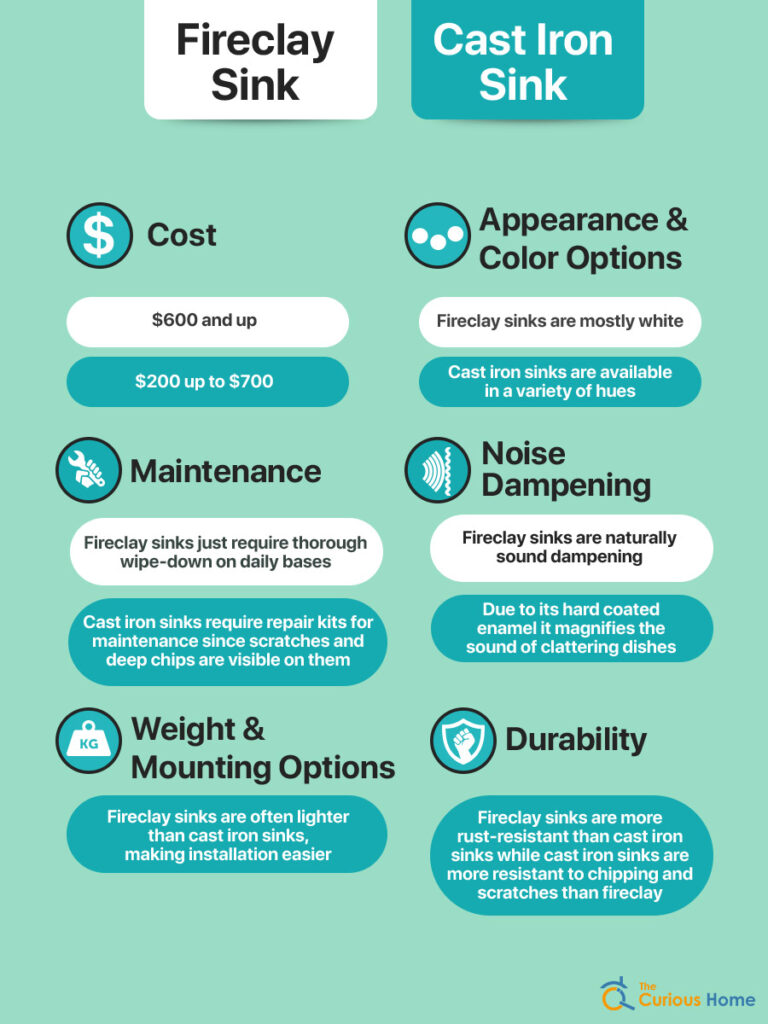
1. Cost
Fireclay sinks are often far more expensive than cast iron choices due to their intensive production process. While cast iron sinks start about $200 and can go up to $700, fireclay sinks typically start around $600 and go up from there. The cost of both may differ depending on the size, brand, and model of the sink. Both types of sinks may cost well into the thousands of dollars, although fireclay sinks are often more expensive.
2. Appearance & Color Options
Cast iron sinks are available in a variety of hues, making it much easier to pick a sink that complements your kitchen. Fireclay sinks are mostly white and don’t come in many other colors. If you are unsure if white will fit with the color scheme of your kitchen, you may struggle to make the sink fit in with your house’s aesthetics.
3. Noise Dampening
Because of the superior density of the fine fireclay formulation, these sinks are naturally sound dampening, eliminating noise and vibration from running water and clattering dishes when the sink is in use, so no exterior soundproofing is required to enjoy a quieter kitchen, whereas this is a difficult scenario to achieve with cast iron due to its hard coated enamel, which magnifies the sound of clattering dishes.
4. Maintenance
A fireclay sink is easier to maintain than a cast iron sink. Because scratches and deep chips are visible on cast iron sinks, it is best to remedy issues as they arise. You may need to purchase repair kits, epoxy, sandpaper, and other items to restore and preserve your cast iron sink.
To keep the fireclay sink looking great, simply give it a thorough wipe-down at the end of the day. Avoid using aggressive cleansers and avoid dumping boiling water down the drain without first running cool water.
5. Weight and Mounting Options
Fireclay sinks are often lighter than cast iron sinks, making installation easier. Because of their weight, cast iron sinks may require the assistance of many individuals to install. Cast iron sinks are heavy, making them difficult to transport and install; extra sink under-mounting may be required to support the weight of cast iron.
A heavily used cast iron sink may also acquire enamel chips; if these chips reach the bare iron, that iron can rust. To be fitted securely, the heavier composition may require extra under-mount support.
6. Durability
There is a clear winner in terms of rust resistance and longevity. Although the longevity of both types is comparable, fireclay sinks are more rust-resistant than cast iron sinks. Rust can occur when cracks and scratches reveal the iron underlying the enamel layer on cast iron sinks.
The enamel coating on cast iron sinks is far more resistant to chipping and scratches than fireclay. Because the underlying substance is the same color as the outside, it hides deep chips far better than cast iron, whereas cast iron is significantly darker than the enamel surface.
Verdict | Should You Get A Fireclay or Cast Iron Sink?
Your personal aesthetics ultimately determines the best kitchen sink for your house. Cast iron sinks are an excellent choice if you want a low-cost, long-lasting sink that will endure the test of time and severe use. However, if you drop sharp or heavy things in the sink, the enamel may crack, exposing the sink to rust.
Fireclay farmhouse sinks are more costly than cast iron sinks, but they are easier to install and last longer. You must use caution when cleaning the sink since abrasive cleansers may harm the enamel. If quality is your first priority, you can’t go wrong with cast iron or fireclay; both are visually appealing and long-lasting materials. Fans of cast iron sinks adore the rustic flavor they add to a kitchen.
Fireclay sinks, on the other hand, are a wonderful choice if you want a high-end, long-lasting sink. They may give your kitchen a classic farmhouse atmosphere while still keeping it clean and elegant. For many, the decision between the two may just be a matter of price. Both products have strengths and limitations, so it is up to you to decide which type of sink is ideal for you.

